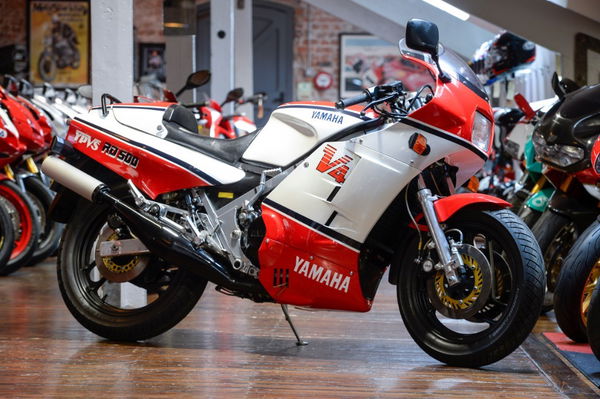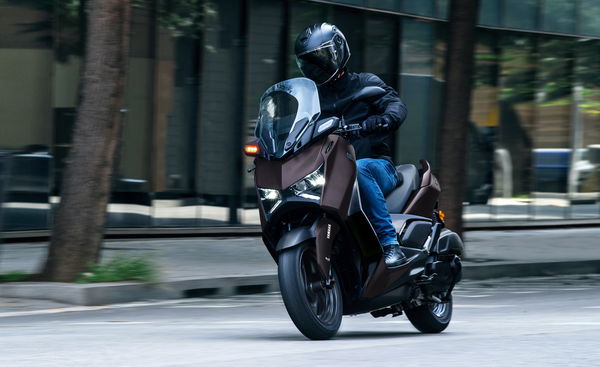LEGENDS FEATURE: Top ten most iconic BSAs of all time
Visordown takes a look at the top ten most iconic BSAs of all time

WITH BSA back in the news with the announcement this week that new Indian owners Mahindra, who bought the historic British brand back in 2016, are planning to re-commence production of BSA petrol motorcycles from a new assembly facility in Birmingham next year, followed by the development of an all-new electric bike line, it got us thinking – what might they be like compared to the great BSAs of the past?
After all, back in the day BSAs had it all: in the early ‘50s it was the biggest motorcycle manufacturer in the world; its fabled Gold Star production racer was the RC30 of its day; it appeared in James Bond films and its Rocket3 triple was not only the fastest bike of its day, it won the Daytona 200 and was the original basis for the famous Craig Vetter/BSA/Triumph X-75 Hurricane one of the most beautiful and collectable bikes of all time.
All of which, obviously, makes BSA’s subsequent 1970s collapse, along with the rest of the British motorcycle industry, all the more poignant.
So now, with the famous brand at last seemingly coming back, when better to revisit those great BSAs of the past – here’s our pick of the best, in chronological order…
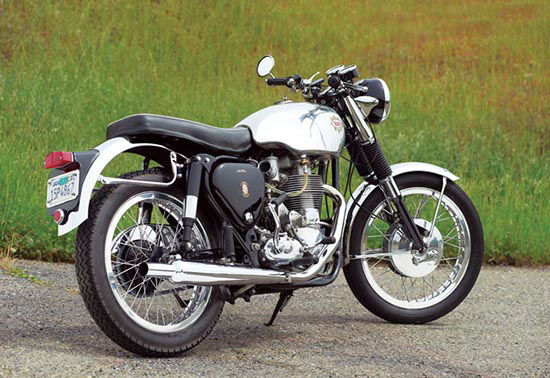
Gold Star (1938-1963)
How better to start than with the Gold Star, but not just because the alloy-barrelled single is arguably the most famous and successful BSA of all, but also because it has one of the longest histories of all, too. By the late 1930s BSA had built a deserved reputation for its performance singles, most notably the 1932 Blue Star, designed by celebrated engineer Val Page and available in 250, 350 and 500cc forms, which then morphed into the Silver Star in 1936, so named to commemorate the Silver Jubilee of King George V that year. The following year, TT star Wal Handley lapped Brooklands for the first time at over 100mph on the 500cc version and awarded a Brooklands ‘Gold Star’ pin in recognition which prompted BSA to make a commemorative Gold Star version the following year. Hand-built with an alloy 496cc engine and lightweight frame it was one of the best performing motorcycles of the day. Post-WW2, bespoke production of 350cc (B32) and 500cc (B34) versions resumed, could be specified in road, trials, enduro, MX (then ‘scrambles’) or road racing trim and proved the most popular production racer of the ‘50s. The move to unit construction ended production in 1963 and today the Gold Star is considered one of the most desirable and successful BSAs of all.
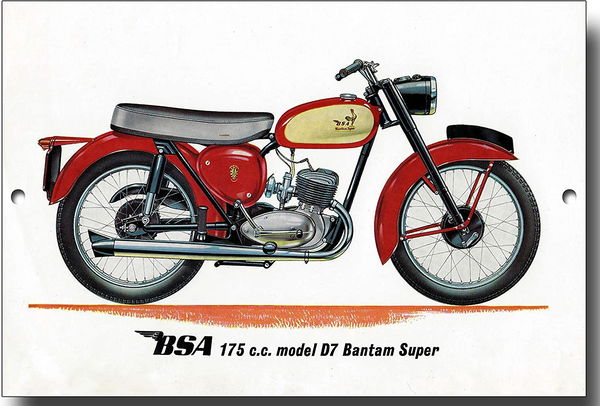
Bantam (1948-1971)
The Bantam was the complete polar-opposite to the Gold Star, being a cheap, utility two-stroke, but that very affordability made it an enormous success, again primarily through the 1950s, with well in excess of 250,000 built. So it may be some surprise that, in truth, the Bantam wasn’t a BSA design at all, instead being based on the German DKW RT125 that was received as war reparations (versions were also made in Russia and Poland). BSA engineers produced a mirror-image of the design to create the traditional British right-hand gearchange and adapted it for Imperial fasteners and the first 125cc Bantam, the D1, went into production in 1948 which, thanks to its bargain £60 price and utilitarian manners proved a big success. A larger 150c D3 followed in 1953 with 175cc versions, with improved suspension and comfort soon after. Production continued through the 1960s and the Bantam remained a popular first bike or commuter, although now aging. BSA reputedly was working on an all-new, alloy-barrelled replacement in 1971 before the company collapsed. Today, the simplicity, value and sheer number of examples means the Bantam remains the go-to British ‘starter classic’ with decent examples available from just £1500.
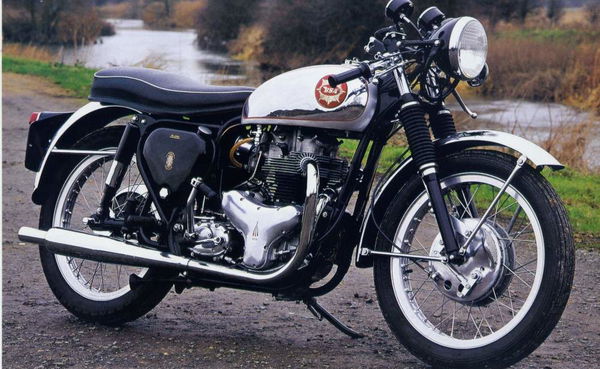
Rocket Gold Star (1962-1963)
This short-lived special was intended as a final hurrah to the pre-unit BSAs in being a road-going amalgam of the best of the breed – a tuned, 50bhp, A10 Super Rocket 650cc parallel twin engine that was smooth for the street but held in the fine-handling double cradle frame from the racing single-cylinder Gold Star. The idea was that of Gold Star tuner and BSA dealer Eddie Dow who first built his own, one-off special. Impressed, BSA management decided to put it into limited celebratory production although cynics have also suggested it was a convenient way to use up pre-unit parts. Just 1584 examples were built of which 272 were in off-road ‘scrambler’ trim primarily aimed at the USA where scramblers were becoming hugely popular. Today, the Rocket Gold Star’s combination of exclusivity, performance and handling make it one of the most collectable BSAs of all, with prices regularly reaching £25K – but watch out: its combination of A10 engine in Gold Star frame also make it easy to replicate, with many non-genuine examples also being made outside of BSA.
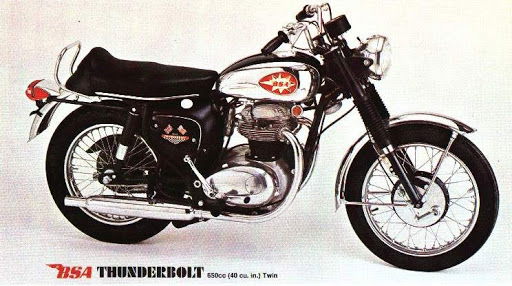
A65 Thunderbolt/Lightning/Spitfire (1962-1972)
The A65 (65 denoting 650cc) twin was BSA’s main big capacity, twin cylinder machine of the 1960s, replacing its pre-unit bikes in 1964, and as such was both BSA’s rival to the likes of the Triumph Tiger/Bonneville 650 and Norton’s Dominator/Atlas/Commando series. Despite its performance not being a match for the Triumph and its handling and style (and price) falling behind that of the Norton, the BSA proved popular for its rugged reliability and value and as such remains a more affordable classic option today. The touring, 46bhp Thunderbolt came first and had a single carburetor (a’la Triumph Tiger), the sports Lightning followed in 1965 with two carbs and 52bhp while the supersports Spitfire (if nothing else, BSA was great at model names) arrived in 1966 with high comp pistons and 54bhp. Claims to fame include the then-new Lightning featuring in the 1965 James Bond film Thunderball, painted gold, with a full fairing and ‘ridden’ by leather-clad villainess Fiona Volpe (although actually ridden by GP racer Bill Ivy). While in 1967 the new Spitfire was used by the travelling marshalls at that year’s Diamond Jubilee TT when Hailwood’s Honda famously battled with Agostini’s MV in the Senior.
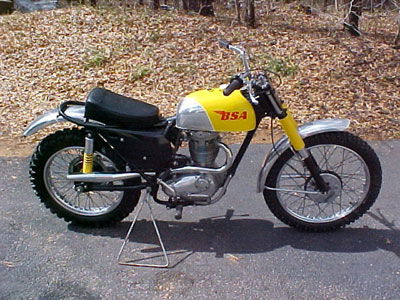
BSA B44-B50 (1964-1971)
BSA was never all about just road bikes – its singles, up to the end of the 1960s, also proving hugely successful off-road both in trails and, particularly, motocross (or ‘scrambles’ as it was called back then) before its heavy four-stroke singles were finally outpaced by a new breed of European (and Japanese) two-stroke lightweights. Its finest hour was arguably in 1964-1965 when factory-supported versions of its B44 single won the world championship in the hands of Jeff Smith. The following year, aboard an updated, renamed version called the ‘Victor’ in commemoration, Smith repeated the feat. Road and trail versions were also subsequently offered. However, despite a massive factory effort in 1966, re-engineering Smith’s bike with titanium, magnesium and aluminium in a bid to cut weight, BSA failed to complete the hat-trick, coming third after a catalogue of reliability problems and cutting the season short after a tragic crash that took the life of racer Jerry Scott. Teammate John Banks continued some success for the BSAs winning GPs in 1968 and 1969 before, in 1971, facing financial meltdown, BSA pulled out, disbanding the team with all the parts bought by Alan Clews, who then founded CCM (Clews Competition Motorcycles) which continues to this day.
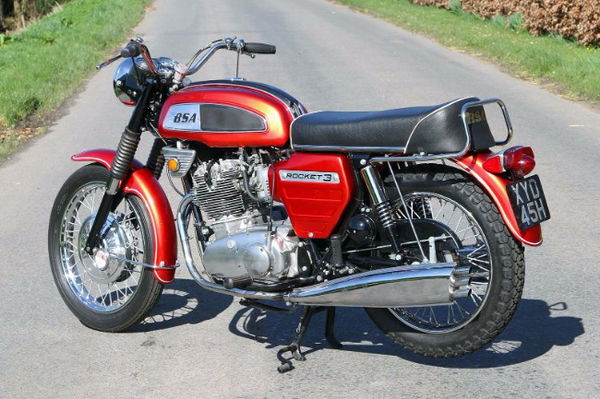
Rocket 3 (1969-1972)
One of the great ‘what ifs’ of British motorcycling. The radical, three-cylinder BSA was originally conceived as the Triumph Trident with a prototype ready as early as 1965 – four years before Honda’s CB750 four and potentially early enough to change the history of British motorcycling. However, delays and redesigns, plus the decision to also produce a BSA version (Triumph was then owned by BSA), which, due to its inclined cylinders required completely re-engineering, delayed production disastrously. Controversially, the styling of the Rocket 3 was also done externally, by Ogle Design, who had no previous experience of motorcycles and are best known for the Raleigh Chopper bicycle, three-wheelers including the Bond Bug and Reliant Robin and, previously, the iconic Bush TR82 portable radio. The result, however, with its ‘square’ tank and ‘ray gun’ silencers, wasn’t received well, particularly in the US and led directly (but unofficially) to the development of the X-75 Hurricane (see below). The Trident, by comparison, was more traditional and better known in the US. As a result, despite winning the Daytona 200 and a more traditional 1971 restyle, sales of the Rocket 3 didn’t meet expectations and, with the company in financial difficulty, production ceased in 1972. The Trident, however, lived on until 1974.
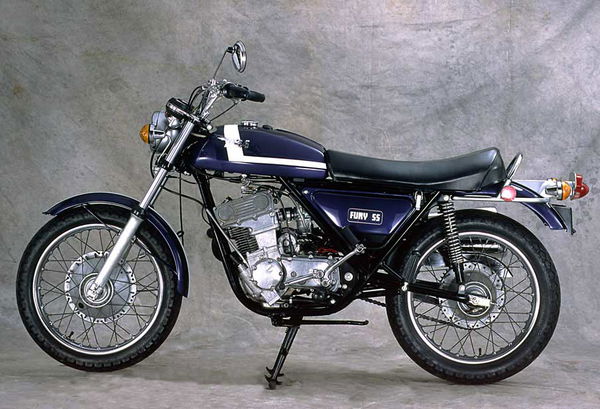
Fury (1970)
Another great ‘what if’ surrounding BSA (and, it has to be said, another great BSA model name, too – here’s hoping the new Mahindra-BSA revives more than a few of them). Also known as the E35, the Fury was a 1970 still-born prototype that, due to BSA’s financial woes, never made it into production but, my, we wish it had. Designed by the great Edward Turner but with significant updates by Bert Hopwood and Doug Hele, the Fury was essentially a BSA version of the equally still-born Triumph Bandit – a 350cc, DOHC performance twin designed to take on the new breed of Japanese lightweight twins. It might have worked, too. The modern engine produced a decent 34bhp, the chassis was designed by Rob North who’d produced the chassis for BSA/Triumph’s Daytona-winning triples and it looked good, too. In fact both bikes were so well developed, eight BSA and five Triumph prototypes were built, it had even been photographed for and included in both brands’ 1971 brochures. American magazine Cycle Guide even tested a pre-production example and gave it a glowing review. Tragically, however, production was cancelled with both companies by then in major financial trouble and the cost of dies and tooling reported as being the major factor. Surviving prototypes can be seen at various museums including the National Motorcycle Museum.

Works Rob North ‘Beezumphs’ (1970-1971)
Although the Rocket 3 proved a commercial failure its biggest success was surely in winning the 1971 Daytona 200, when a squad of no less than 10 specially developed racers, five in BSA Rocket 3 and five in Triumph Trident guises/livery, entered the famous Florida race in an assault of excessive spending the factory simply could not afford in what is now considered the last great crusade of the then dying British motorcycle industry. It all came about due to a failure the previous year. In 1970 BSA/Triumph launched a slightly smaller assault on the race to publicise its new triples as the race’s new Formula 750 class was deemed perfect to give maximum exposure in the vital US market. Unfortunately, despite race-prepping the motors, using bespoke race frames by Rob North and special bodywork developed in an RAF wind tunnel, and employing riders including Mike Hailwood, Gary Nixon and Gene Romero, the four Triumphs and two BSAs were pipped by American rider Dick Mann, himself normally a BSA rider, aboard the new Honda CB750. Incensed, the team returned even bigger in 1971, used an improved ‘low-boy’ version of the North frame, re-hired Mann and swept the board, Mann winning aboard a BSA version ahead of Romero (Triumph) and Don Emde (BSA). Due to financial constraints a much-reduced team returned in 1972 with Mann finishing fourth. Hailwood’s bike, which retired on lap 14 of the 1971 race, was destroyed by the fire at the National Motorcycle Museum in 2003 but has been subsequently rebuilt. Rob North makes replica frames to this day. Surviving original race bikes have sold for well in excess of £125,000.
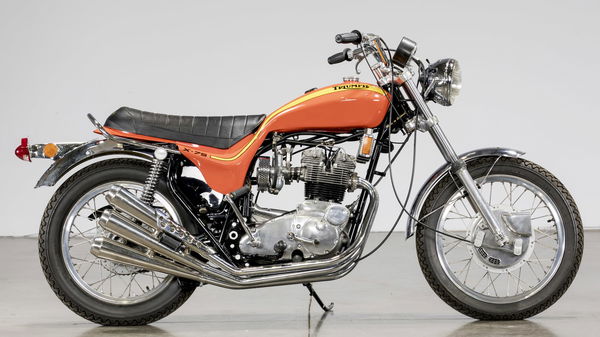
BSA/Triumph X-75 Hurricane (1970-1973)
It’s one of British motorcycling’s most infamous stories – the American-inspired creation by Craig Vetter of the radical Triumph X-75 Hurricane, which today is one of the most collectable British bikes of all. But it’s also one whose roots are very much BSA. Essentially, the story goes that, following the unveiling of the Ogle-designed BSA Rocket 3, BSA America executive Don Brown, dismayed by its styling, unofficially commissioned up-coming ‘hippie’ designer Craig Vetter to do a design study then mock-up of what a version for the American market could look like. The ‘Vetter BSA Rocket’ was the result, starred on the cover of Cycle World in 1970 and eventually overcame management distrust to finally go into limited production in 1973. By then, however, BSA had closed its doors so it instead became a Triumph. Just 1200 were built, all today being highly valued collectors machines. The original prototype ‘BSA Hurricane’ is now on display as the AMA Motorcycle Museum Hall of Fame in Ohio.

A70 Lightning (1971)
If BSA’s A65 family of twins was its ‘bread and butter’ big bike of most of the 1960s and early ‘70s, then the short-lived, enlarged A70 version is one of its rarest. Built briefly in 1971 as a ‘homologation special’ it was conceived to be an enlarged, 750cc version of the previously 650cc twin to enable the BSA to qualify and fully exploit the new 750cc limit for US flat track racing as introduced in 1969 – a race series then considered vital for US sales success. The rules required racers to be based on production machines of which 200 must be built. BSA duly built actually 202 A70 Lightnings, 65 in June, 101 in July and 36 in August of 1971 and duly shipped them out. Outwardly, they’re identical to the 650 bar the ‘750’ badge on the side panels. Inwardly, however, there’s a new crank giving a longer stroke, high-compression pistons and bigger carbs giving genuine 120mph potential. Rocket 3 aside, the A70 is also one of the rarest and last of the later big-bore BSAs…
